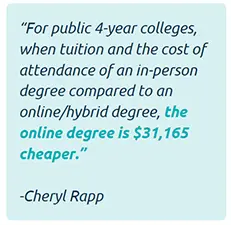Embracing Hybrid and Online Learning
The Future of Education and Its Impact on College Savings
By: Cheryl Rapp, Wisconsin Department of Financial Institutions
published October 4, 2024

As a parent of two teenage boys who are starting to think about going to college, I have noticed that in recent years, the college landscape has undergone significant transformations driven by technological advancements and the evolving needs and desires of students.
One of the most notable changes I have seen is the rise of hybrid and online learning, which combines traditional in-person instruction with online education. While these models offer a flexible approach to learning so that students can work or have a family life while going to college, many do not think about how cost-effective this approach to learning can potentially be when it comes to saving for higher education.
The Evolution of Hybrid and Online Learning
College doesn’t look like what it used to when I went to school. Nowadays, the hybrid and online learning models allow students access to learning materials and assignments online while benefiting from direct interaction with teachers and peers during in-person or on-campus sessions. This format is extremely helpful for students who need flexibility for things such as work or family commitments while also preparing them for the increasingly digital world they will encounter in their careers.
The COVID-19 pandemic accelerated the adoption of hybrid and online learning, demonstrating its viability and effectiveness in delivering quality education. For example, the University of Wisconsin–Oshkosh offers a wide variety of online and hybrid undergraduate, graduate, and professional certificate programs, in fields like criminal justice, healthcare, management, and more.1
Cost Savings through Hybrid and Online Learning
Hybrid and online learning have the potential to significantly reduce the overall cost of higher education. By incorporating online components, colleges and universities can lower operational expenses associated with maintaining physical infrastructure, such as classrooms, housing, and utilities. These savings can be passed on to students in the form of reduced tuition fees. According to the Education Data Initiative (2023), for public 4-year colleges, when tuition and the cost of attendance of an in-person degree compared to an online/hybrid degree, the online degree is $31,165 cheaper.2

Additionally, with the ability to complete a portion of their coursework online, students can choose to live at home or in more affordable housing options rather than on-campus dormitories. Costs for food, rent, internet, and other expenses may not be needed if the student lives for free with their family or commutes to school from their parent’s home.2 This reduction in living expenses can lead to substantial savings over the course of a college education.
Maximizing College Savings with 529 Plans
Given the potential cost savings associated with hybrid and online learning, families should consider leveraging 529 college savings plans to maximize their college savings. A 529 plan is a tax-advantaged savings and investment account designed to help individuals and families with future education expenses. These plans offer several benefits that align well with the financial advantages of hybrid learning.
Contributions to a 529 plan grow tax-deferred, and withdrawals used for qualified education expenses are tax-free at the federal level. Many states, including Wisconsin, also offer state income tax deductions or credits for contributions to a 529 plan. By investing in a 529 plan, families can reduce their tax burden while accumulating funds for education.
Combining the tax advantages of 529 plans with the cost-saving potential of hybrid learning can empower families to effectively save for their children's education while also embracing innovative educational opportunities. This approach not only helps families financially prepare for the future but also supports the broader goal of making quality education more affordable and accessible to all students.
Planning for the Future
As hybrid and online learning continues to gain traction, it is essential for families to stay informed about the evolving educational landscape and adjust their financial planning strategies accordingly. Remember to explore online and hybrid learning as an option and consider how pursuing even a portion of higher education this way might impact your overall college costs. By embracing different types of learning and taking advantage of the benefits offered by 529 plans, families can make education more affordable and accessible.
###
To learn more about Wisconsin's Edvest 529 College Savings Plan, its investment objectives, risks, charges and expenses see the Plan Description at Edvest.com before investing. Read it carefully. Investments in the Plan are neither insured nor guaranteed and there is the risk of investment loss. Wisconsin taxpayers can qualify for a 2024 state tax deduction up to $5,000 annually per beneficiary, for single filer or married couple filing a joint return, from contributions made into an Edvest 529 College Savings Plan. Married couples filing separately may each claim a maximum of $2,500. Prior to investing, check with your home state to learn if it offers tax or other benefits such as financial aid, scholarship funds or protection from creditors for investing in its own 529 plan. Consult your legal or tax professional for tax advice. If the funds aren't used for qualified higher education expenses, a federal 10% penalty tax on earnings (as well as federal and state income taxes) may apply. Consult your legal or tax professional for tax advice. TIAA-CREF Individual & Institutional Services, LLC, Member FINRA, distributor and underwriter for the Edvest 529 College Savings Plan.
Neither TIAA-CREF Tuition Financing, Inc., nor its affiliates, are responsible for the content found on any external website links contained herein.
This testimonial was provided by an Edvest 529 account owner and State of Wisconsin employee, and no direct or indirect compensation was given in return. No material conflicts of interest exist on the part of the account owner(s) giving the testimonial, resulting from their relationship with TIAA-CREF Tuition Financing, Inc. Results experienced by the account owner(s) may not be representative of the experience of another/other account owner(s), and there is no guarantee of future performance or success.
Sources
- 1Source: University of Wisconsin – Oshkosh; Academic Affairs, https://www.uwosh.edu/academic-affairs/resources/online-and-hybrid-academic-programs/↩
- 2Source: Education Data, Cost of Online Education vs. Traditional Education, https://educationdata.org/cost-of-online-education-vs-traditional-education↩
FGN-3756714CR-E0924W
More to explore
-
Explore our plan
Learn more about eligibility and all the qualifying expenses an Edvest 529 account can cover.
How our 529 works -
Compare investment portfolios
We make it easy to choose investment portfolios that fit your financial needs and savings goals.
Discover your options -
Ready to get started?
Open an Account